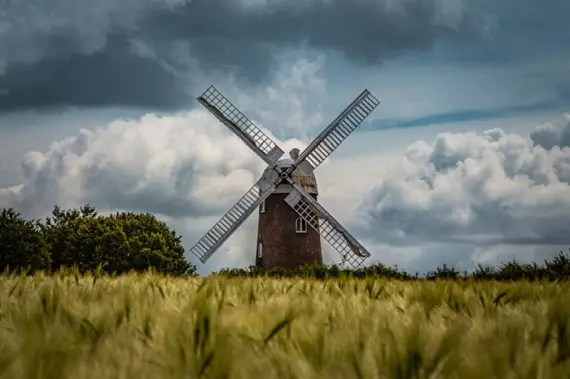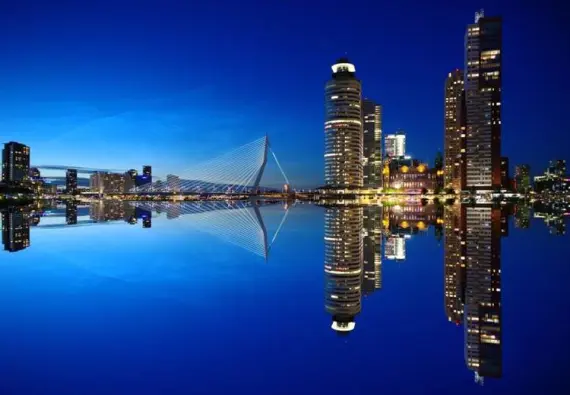Bus from OZIMEK to ROTTERDAM - find a connection and buy a ticket
OZIMEK

Ozimek is a town of less than 9,000 people in Opolskie Province, 21 kilometers east of Opole, 6 kilometers from the popular Turawa Lakes. It lies on the Opole Plain, on the Mała Panwa River. Originally Ozimek was called Małpądew, and later Małpanew, due to its location on the Mała Panwia River. The name Ozimek is most likely derived from the name of the owner of a nearby mill, and over time came to be used to refer to the industrial settlement next to a steel mill established in the second half of the 18th century.
The village's biggest attraction is the oldest iron suspension bridge in Europe, dating back to 1827, crossed over the Mała Panew River. The nearby 19th-century Evangelical Augsburg Church is also worth seeing. A major attraction in the area is also Jurapark Krasiejów, which combines the study of prehistory and evolution with entertainment for the whole family.
Ozimek can prove to be an attractive destination not only for those who love history and technological monuments. It is also an excellent starting point for those who enjoy hiking and biking. In addition, Turawskie Lake is a great place for fishing and water sports, and Mała Panew provides opportunities for canoeing.
Getting to Ozimek
A national and provincial road runs through Ozimek, and the town is close to the A4 highway. There is a railroad station in the city and an Ozimek PKS bus stop located on Kolejowa Street near the iron suspension bridge. There are buses running from it on local as well as national and international routes. You can check all available bus tickets and connections on our website.
Ozimek is a town of less than 9,000 people in Opolskie Province, 21 kilometers east of Opole, 6 kilometers from the popular Turawa Lakes. It lies on the Opole Plain, on the Mała Panwa River. Originally Ozimek was called Małpądew, and later Małpanew, due to its location on the Mała Panwia River. The name Ozimek is most likely derived from the name of the owner of a nearby mill, and over time came to be used to refer to the industrial settlement next to a steel mill established in the second half of the 18th century.
The village's biggest attraction is the oldest iron suspension bridge in Europe, dating back to 1827, crossed over the Mała Panew River. The nearby 19th-century Evangelical Augsburg Church is also worth seeing. A major attraction in the area is also Jurapark Krasiejów, which combines the study of prehistory and evolution with entertainment for the whole family.
Ozimek can prove to be an attractive destination not only for those who love history and technological monuments. It is also an excellent starting point for those who enjoy hiking and biking. In addition, Turawskie Lake is a great place for fishing and water sports, and Mała Panew provides opportunities for canoeing.
Getting to Ozimek
A national and provincial road runs through Ozimek, and the town is close to the A4 highway. There is a railroad station in the city and an Ozimek PKS bus stop located on Kolejowa Street near the iron suspension bridge. There are buses running from it on local as well as national and international routes. You can check all available bus tickets and connections on our website.
ROTTERDAM

Rotterdam is a large port city in the west of the Netherlands in the Province of South Holland with a population of over 620,000. It lies in the Rhine-Meuse delta, and is connected to the North Sea by the 30-kilometer-long Nieuwe Waterweg canal.
Rotterdam was first mentioned in 1283. It received city rights in 1299, and developed significantly in the 17th and 18th centuries through trade with France and England or the shipping industry. Rotterdam's seaport already played a significant role in the life of the city and still impresses today with its size and capabilities.
If you want to get to know Rotterdam, start your tour with the Gothic St. Lawrence Church, one of the most distinctive buildings, also one of the oldest, but which suffered significantly during the Luftwaffe carpet raids of 1940 - its walls and tower survived then. Today, in addition to its beautiful facade, the church's interior is worth seeing, with its historic altars and tombs. The city also boasts a number of museums full of valuable art collections. Particularly noteworthy is the large Boijmans Van Beuningen museum collecting works by many famous artists, or the Kunsthal Art Museum, which hosts temporary and thematic exhibitions.
Rotterdam is a city that is constantly vibrant. There you can find numerous clubs, discos and pubs, plus there are many events, concerts and festivals. In the summer there is a good chance that you will come across one of the numerous open-air performances, and in the winter - a fair or Christmas market.
Getting to Rotterdam
Rotterdam is a major transportation hub, where highways and railroads intersect. In addition, you'll find an airport and the largest seaport in Europe. The city has five subway lines, as well as streetcars and buses, so getting around Rotterdam and other towns in the metropolitan area in the western Netherlands should not be a problem.
Our buses stop near the Erasmusbrug suspension bridge and the Kunsthal Museum on Zalmstraat 9. Wanting to visit Rotterdam - a bus can be a great choice, especially since it is an inexpensive and more environmentally friendly option than flying or driving your own car. You can find a list of available bus connections to Rotterdam on our website.
Rotterdam is a large port city in the west of the Netherlands in the Province of South Holland with a population of over 620,000. It lies in the Rhine-Meuse delta, and is connected to the North Sea by the 30-kilometer-long Nieuwe Waterweg canal.
Rotterdam was first mentioned in 1283. It received city rights in 1299, and developed significantly in the 17th and 18th centuries through trade with France and England or the shipping industry. Rotterdam's seaport already played a significant role in the life of the city and still impresses today with its size and capabilities.
If you want to get to know Rotterdam, start your tour with the Gothic St. Lawrence Church, one of the most distinctive buildings, also one of the oldest, but which suffered significantly during the Luftwaffe carpet raids of 1940 - its walls and tower survived then. Today, in addition to its beautiful facade, the church's interior is worth seeing, with its historic altars and tombs. The city also boasts a number of museums full of valuable art collections. Particularly noteworthy is the large Boijmans Van Beuningen museum collecting works by many famous artists, or the Kunsthal Art Museum, which hosts temporary and thematic exhibitions.
Rotterdam is a city that is constantly vibrant. There you can find numerous clubs, discos and pubs, plus there are many events, concerts and festivals. In the summer there is a good chance that you will come across one of the numerous open-air performances, and in the winter - a fair or Christmas market.
Getting to Rotterdam
Rotterdam is a major transportation hub, where highways and railroads intersect. In addition, you'll find an airport and the largest seaport in Europe. The city has five subway lines, as well as streetcars and buses, so getting around Rotterdam and other towns in the metropolitan area in the western Netherlands should not be a problem.
Our buses stop near the Erasmusbrug suspension bridge and the Kunsthal Museum on Zalmstraat 9. Wanting to visit Rotterdam - a bus can be a great choice, especially since it is an inexpensive and more environmentally friendly option than flying or driving your own car. You can find a list of available bus connections to Rotterdam on our website.
© 2025 Sindbad
Technical support, assistance, payments: Sindbad IT
© 2025 Sindbad
Technical support, assistance, payments: Sindbad IT
